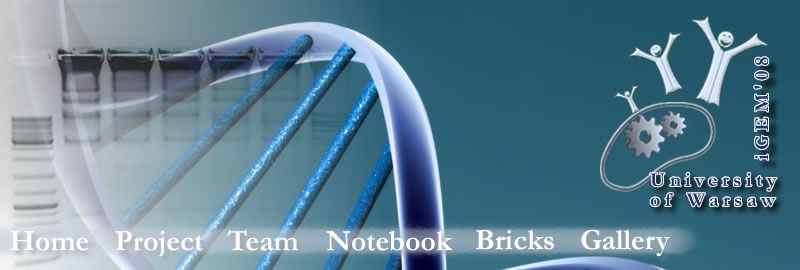Team:Warsaw/Calendar-Main/13 May 2008
From 2008.igem.org
(Difference between revisions)
MKrzyszton (Talk | contribs) |
MKrzyszton (Talk | contribs) |
||
| (28 intermediate revisions not shown) | |||
| Line 1: | Line 1: | ||
{{WarNotebook}} | {{WarNotebook}} | ||
| - | <html> | + | <html><h3>Preparation of <a href=https://2008.igem.org/Wiki/Team:Warsaw/vectors/pMPM-T5-AID>pMPMT5+AID</a> construct</h3> |
| + | <h4>Michał K.</h4> | ||
| - | <p | + | <p> |
| - | + | Setup of separate cultures from colonies of transformants <a href=https://2008.igem.org/Wiki/Team:Warsaw/vectors/pMPM-T5-AID>pMPMT5+AID</a> (liquid LB+tetracycline).</p> | |
| - | < | + | |
| + | |||
| + | |||
| + | <h3>Preparation of <a href=https://2008.igem.org/Wiki/Team:Warsaw/vectors/pMPM-T5%2BAID%2BT7>pMPMT5-AID+T7</a> and <a href=https://2008.igem.org/Wiki/Team:Warsaw/vectors/pMPM-T5%2BAIDT7>pMPMT5+AID-T7</a></h3> | ||
| + | <h4>Michał K.</h4> | ||
| + | |||
| + | <ol> | ||
| + | <li> Optimization of conditions for <html><a href="https://2008.igem.org/wiki/index.php?title=Wiki/Team:Warsaw/protocols#pcr">PCR</a> to obtain AID DNA fragment - annealing temperature gradient (from 62°C to 82°C). <a href="https://2008.igem.org/Team:Warsaw/Calendar-Main/13_May_2008#fig1">Fig. 1</a>.<br> | ||
| + | Primers: | ||
| + | |||
| + | |||
| + | <a href="https://2008.igem.org/Wiki/Team:Warsaw/primers#AIDlNrH">AIDlNrH</a> | ||
| + | <a href="https://2008.igem.org/Wiki/Team:Warsaw/primers#AIDpLinB">AIDpLinB</a> | ||
| + | <br> | ||
| + | |||
| + | Template DNA: <a href=https://2008.igem.org/Wiki/Team:Warsaw/vectors/pTrc99A-AID>pTrc99A-AID</a> | ||
| + | <br> | ||
| + | |||
| + | Elongation time: 60 sec <br> | ||
| + | |||
| + | 20 cycles </li> | ||
| + | |||
| + | |||
| + | <li> Optimization of conditions for <html><a href="https://2008.igem.org/wiki/index.php?title=Wiki/Team:Warsaw/protocols#pcr">PCR</a> - T7 RNA polymerase for translational fusion; annealing temperature gradient (from 62°C to 82°C). <a href="https://2008.igem.org/Team:Warsaw/Calendar-Main/13_May_2008#fig2">Fig. 2</a>.<br> | ||
| + | |||
| + | Primers: | ||
| + | |||
| + | |||
| + | <a href="https://2008.igem.org/Wiki/Team:Warsaw/primers#T7lLinkB">T7lLinkB</a> | ||
| + | <a href="https://2008.igem.org/Wiki/Team:Warsaw/primers#T7pXbSal">T7pXbSal</a> | ||
| + | <br> | ||
| + | |||
| + | |||
| + | Template DNA: <i>E. coli</i> <a href="https://2008.igem.org/Wiki/Team:Warsaw/igem_notebook.htm#rosetta">Rosetta</a> genomic DNA<br> | ||
| + | |||
| + | Elongation time: 4 minutes | ||
| + | <br> | ||
| + | |||
| + | 20 cycles<br> | ||
| + | |||
| + | |||
| + | |||
| + | </li> | ||
| + | <li> Optimization of conditions for <html><a href="https://2008.igem.org/wiki/index.php?title=Wiki/Team:Warsaw/protocols#pcr">PCR</a> - T7 RNA polymerase for transcriptional fusion; annealing temperature gradient (from 62°C to 82°C). <a href="https://2008.igem.org/Team:Warsaw/Calendar-Main/13_May_2008#fig2">Fig. 2</a>. <br> | ||
| + | |||
| + | Primers: | ||
| + | |||
| + | |||
| + | <a href="https://2008.igem.org/Wiki/Team:Warsaw/primers#T7lRBSHi">T7lRBSHi</a> | ||
| + | <a href="https://2008.igem.org/Wiki/Team:Warsaw/primers#T7pXbSal">T7pXbSal</a> | ||
| + | <br> | ||
| + | |||
| + | |||
| + | Template DNA: <i>E. coli</i> <a href="https://2008.igem.org/Wiki/Team:Warsaw/igem_notebook.htm#rosetta">Rosetta</a> and <a href="https://2008.igem.org/Wiki/Team:Warsaw/igem_notebook.htm#top10">TOP10</a> (negative control - <a href="https://2008.igem.org/Team:Warsaw/Calendar-Main/13_May_2008#fig3">Fig. 3</a>.) genomic DNA<br> | ||
| + | |||
| + | |||
| + | |||
| + | Elongation time: 4 minutes<br> | ||
| + | |||
| + | 20 cycles <br> | ||
| + | |||
| + | |||
| + | </li> | ||
| + | <li> Gel electrophoresis of PCR products (there weren't any products for T7 RNA polymerase for translational fusion).</li> | ||
| + | </ol> | ||
| + | </p> | ||
| + | |||
| + | <a name="fig1"><img src="https://static.igem.org/mediawiki/2008/7/71/Aid_pcr_grad_WAW.jpg" width=350/></a><var><b>Fig. 1.</b> Gradient PCR products for AID:<br> <b>1</b> -DNA ladder; <b>2 to 13</b> -PCR products: In lane <b>2</b> is product of PCR reaction with annealing temperature 62°C (the lowest temperature of gradient), in lane <b>13</b> is product of PCR reaction with annealing temperature 82°C (the highest temperature of gradient). The lanes between them contain products of PCR with middle annealing temperatures.</var> | ||
| + | |||
| + | <a name="fig2"><img src="https://static.igem.org/mediawiki/2008/9/97/T7grad_WAW1.jpg" width=350/></a> | ||
| + | <var><b>Fig. 2.</b> Gradient PCR products: upper - for transcriptional fusion, lower - for translational fusion; 1-DNA ladder; 2 to 12-PCR products-border annealing temperatures of gradient: 62°C (lane 2) to 82°C (lane 12)</var> | ||
| + | |||
| + | <a name="fig3"><img src="https://static.igem.org/mediawiki/2008/6/6c/T7grad_WAW2.jpg" width=350/></a> | ||
| + | <var><b>Fig. 3.</b> Gradient PCR products for negative control (Top10 genomic DNA): 1-DNA ladder; 2 to 6-PCR products-border annealing temperatures of gradient: 62°C (lane 2) to 82°C (lane 6).</var> | ||
</html> | </html> | ||
| + | |||
| + | |||
{{WarNotebookEnd}} | {{WarNotebookEnd}} | ||
Latest revision as of 13:50, 26 October 2008
 |
|||||||||
Preparation of pMPMT5+AID constructMichał K.Setup of separate cultures from colonies of transformants pMPMT5+AID (liquid LB+tetracycline). Preparation of pMPMT5-AID+T7 and pMPMT5+AID-T7Michał K.
 Fig. 1. Gradient PCR products for AID: Fig. 1. Gradient PCR products for AID:1 -DNA ladder; 2 to 13 -PCR products: In lane 2 is product of PCR reaction with annealing temperature 62°C (the lowest temperature of gradient), in lane 13 is product of PCR reaction with annealing temperature 82°C (the highest temperature of gradient). The lanes between them contain products of PCR with middle annealing temperatures.  Fig. 2. Gradient PCR products: upper - for transcriptional fusion, lower - for translational fusion; 1-DNA ladder; 2 to 12-PCR products-border annealing temperatures of gradient: 62°C (lane 2) to 82°C (lane 12)
Fig. 2. Gradient PCR products: upper - for transcriptional fusion, lower - for translational fusion; 1-DNA ladder; 2 to 12-PCR products-border annealing temperatures of gradient: 62°C (lane 2) to 82°C (lane 12)
 Fig. 3. Gradient PCR products for negative control (Top10 genomic DNA): 1-DNA ladder; 2 to 6-PCR products-border annealing temperatures of gradient: 62°C (lane 2) to 82°C (lane 6).
Fig. 3. Gradient PCR products for negative control (Top10 genomic DNA): 1-DNA ladder; 2 to 6-PCR products-border annealing temperatures of gradient: 62°C (lane 2) to 82°C (lane 6).
|
 "
"





